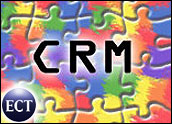
Growing companies encounter various bottlenecks that inhibit growth and cause them to plateau. It starts innocently enough. Everyone reaches for a spreadsheet to make lists:
- Marketing gets a list of prospects.
- The sales department uses that plus their own data to create a list of qualified prospects. They also have a list of customers.
- Accounting creates their own list of customers to track receivables.
- The product guys have a list of inventory.
Things are fine while there are only three or four of you. Then the new hire in sales creates his own list of customers. Accounting hires an administrator who starts a list of office supplies plus her own mailing list, derived from the other customer and prospect lists. Pretty soon, you not only have confusion over who has what, but also management is pretty annoyed that a consolidated sales forecast takes hours instead of minutes to produce.
Perfect for Listing
“Spreadsheet suffocation” is that stage of information sharing pain that causes people to start cussing.
However, don’t completely pan spreadsheets.
Spreadsheets are easy to use and flexible. They slice; they dice; they practically make julienne fries. We all seem to grab a spreadsheet first when we’re making a list. They are perfect for listing, sorting, calculating and summarizing. The charting function is pretty fine too. However, there are things they don’t do well at all.
Spreadsheets are not good at set logic. “Show me all the prospects in SIC code 12345.” This is a set query — I want a certain set of facts, filtered by things I know. That’s easy, you say — just sort the data by SIC code and lift the records you want.
Drilling Down
Fair enough, but what if we add more criteria. “Show me all the financial service companies in Atlanta that grossed more than (US)$2 million last year and have more than five people.”
Creating a list of items that fit a complex set of criteria — a set — is not so easy in spreadsheet land. It’s not that a spreadsheet cannot do this, it just isn’t natural. You are trying to drive a nail with a crescent wrench. Sure, you can do that, but you’ll make a mess and annoy everyone nearby. This is a job for a database product, where querying and reporting on data comes naturally. That’s why they exist.
Spreadsheets are also not good at providing simultaneous updates by multiple people, protecting data quality through validation rules, hiding sensitive data from selected employees and numerous other chores that are routine for a database application.
When a team of people reach this point — whether it is a small company or a department within a larger enterprise — it needs a way to share data that is safe, fast and reliable. The pain of trying to collaborate is now so high that they are suffocating — a significant growth bottleneck has set in.
Buying Enterprise Software
No problem, you think: We obviously need a customer relationship management system.
“Tell me the top three,” says management, “and we’ll pick one.”
Top three according to whom? Sorted by what criteria? Written for what types of companies? Containing what mix of features? Let’s back up.
Buying software is not as easy as buying a car. Cars perform the same basic function year after year — they allow people to get from A to B without getting wet.
Buying a specific car involves many other decision factors including style, comfort, economy and brand loyalty. However, these are secondary factors. You wouldn’t buy the best-looking car if it only turned left, and great gas mileage is useless if the vehicle won’t stop.
Basics matter, but this is obvious. So obvious, in fact, that you wouldn’t think to ask about them when making your car selection.
Tough Choices
Unfortunately, getting “the basics” in a software package is not as straightforward. One would hope that a software developer that describes its product as “customer relationship management” has done a bang-up job on the basics. However, what is a CRM system and how do you judge the effectiveness of a given product on said basics? Does it only handle relationships with customers, or might it also provide ways to track activity for almost-customers (aka qualified prospects)? How about new leads? Wait, isn’t that the job of a lead generation system?
To avoid a poor purchase and have the confidence that you bought the best CRM (or any other enterprise application) you could afford, the selection process should move through a logical series of steps, drilling downward from most important to least important:
- Why? Why do we need a CRM system? What is the expected return on this investment? Are we sure that we need a CRM system, or is there another area of the company that needs automating first?
- Who? Who will the system affect? That is, what are all of the different types of users the system must satisfy? These are sometimes called “actors” or “roles” during analysis. At a minimum, you need to think about sales staff, sales support staff (because you know that salespeople are not administrative by nature), marketing staff, managers, assistants, customers and prospects. It is tempting to skip this step, but if you do some audiences will not be properly represented in the next step and the effort will be shortsighted. This raises the risk of choosing poorly.
- What? What must the system do? Do we need account management? Lead tracking? Marketing campaigns? Support tickets? What about remote access? Be specific as you write down your needs. Instead of saying that the system “must be flexible” (a meaningless phrase in software development), specify that a given account must be shareable by multiple sales staff, with assigned commission percentages.
The exact requirements will depend on your business model, which is why buying one of the “top three” products won’t make any sense until you have carefully defined your needs. Consider, too, what other systems this might want to integrate. Does it have an API (application programming interface) or Web service that you can tap when customizing?
Selecting new software for your company is a project and it should be treated that way. Navigating this process with confidence requires a project champion. Pick someone who can interview the stakeholders, organize the results and manage the conversation with potential vendors. If, as in most small companies, everyone is too busy to take on this extra work, then find an experienced consultant who doesn’t have a horse (product) in the race. Objectivity is important when shopping for a “best fit” solution.
Michael Wilkes is founder and chief disambiguator of Dynamic Answers, which helps small companies buy and use technology wisely.















































This is a great article and quite true to life.
Small businesses should accept that at a point they will need to migrate off their spreadsheet. They need to check that their spreadsheet data is captured in a conventional format otherwise they will struggle to import it into their shiny new CRM.
Gather all prospective users of the CRM, and go over the points you mention above. But before evaluating a couple of CRM’s from a choice of several hundred, read one or two good books on the subject to avoid expensive anguish later.
Perry Norgarb
SmallBizCRM.com